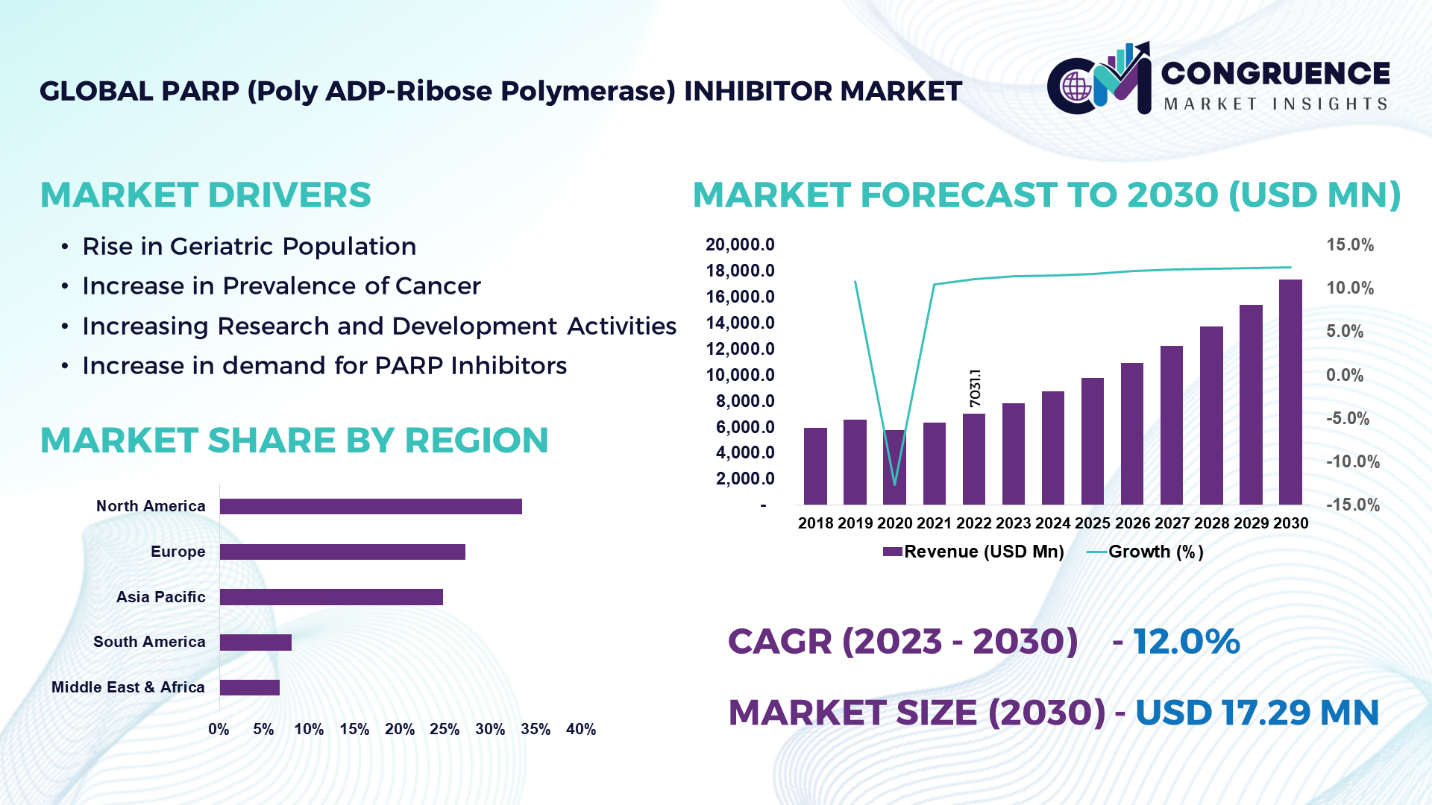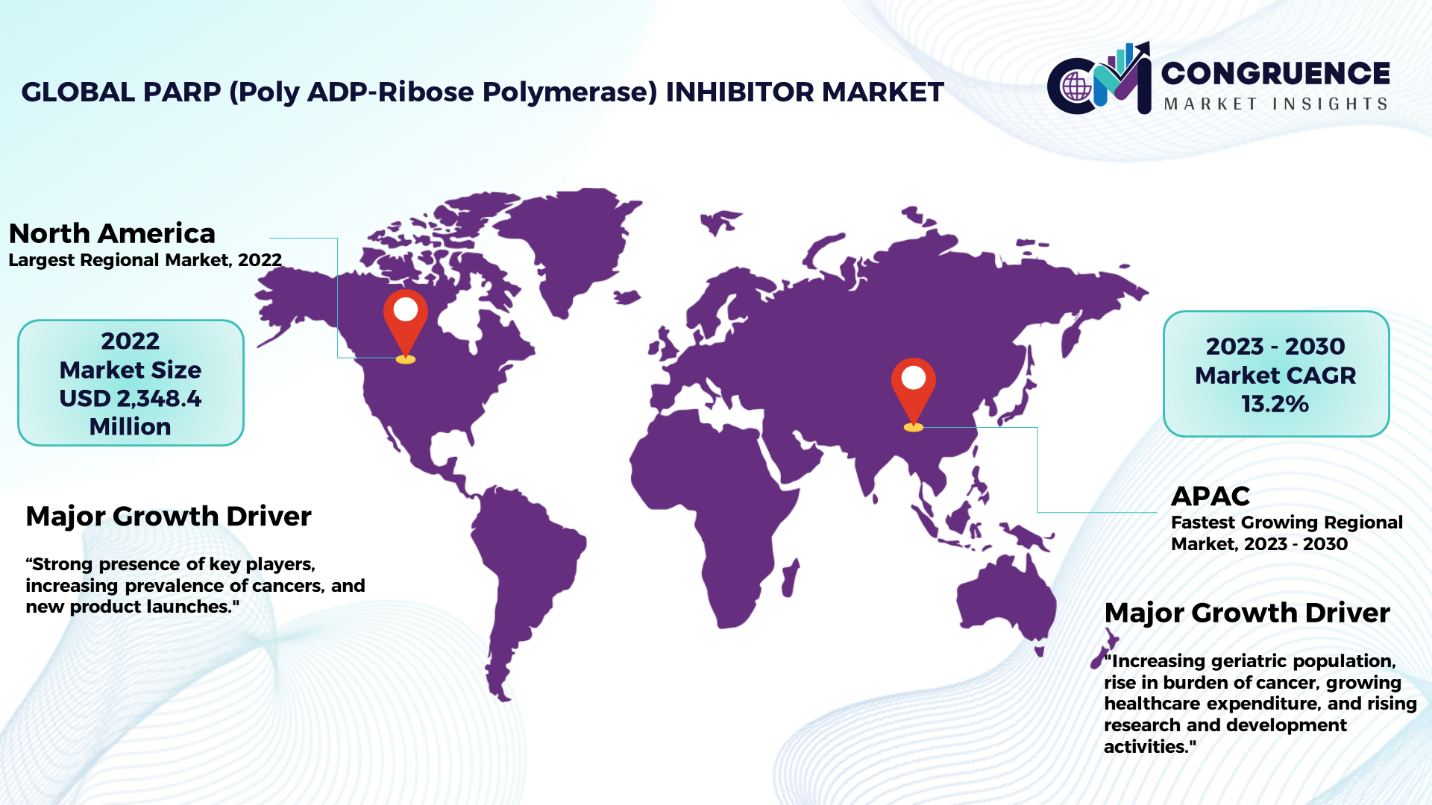Reports
The Global PARP (Poly ADP-Ribose Polymerase) Inhibitor Market was valued at USD 7,031.1 Million in 2022 and is anticipated to reach a value of USD 17,293.6 Million by 2030 expanding at a CAGR of 12.0% between 2023 and 2030.
PARP (Poly ADP-Ribose Polymerase) inhibitor is a type of targeted cancer drug that blocks PARP enzyme in the cell. PARP inhibitors are a type of medication that works by preventing cancer cells from repairing the damaged part of their DNA. These inhibitors are developed for multiple indications, including the treatment of heritable cancers. Several forms of cancer are more dependent on PARP than regular cells, which makes them an attractive target for cancer therapy. In a cancer treatment, PARP inhibitors stop the PARP from doing its repair work in cancer cells and the cell dies. They are used as treatment for several types of cancer including breast cancer, ovarian cancer, prostate cancer, pancreatic cancer, and other cancers. Based on drug types, PARP inhibitors can be classified into olaparib, niraparib, rucaparib, talazoparib, veliparib, and other drugs. PARP inhibitors are primarily used in healthcare sector including hospitals, specialty clinics, homecare, and other research institutes.

PARP (Poly ADP-Ribose Polymerase) Inhibitor Market Major Driving Forces
Rise in Geriatric Population: The rising number of geriatric population worldwide is a major driver of PARP inhibitor market. The aging population are associated with higher risk of cancer and are more prone to develop diseases. The increasing geriatric population and growing medical needs drives the PARP inhibitors market growth.
Increase in Prevalence of Cancer: The growing burden of cancer worldwide is the leading factor favoring the growth in the market. Increasing cancer incidence globally resulting rise in cancer burden drives the demand for PARP (Poly ADP-Ribose Polymerase) inhibitors. Increase in prevalence of cancer across the globe is expected to boost the global PARP inhibitors market.
Increasing Research and Development Activities: Key players are focus on research and development to develop new products, which drives the PARP inhibitors market growth. Moreover, researchers are focused on expanding the applications of PARP inhibitors which further fuels the market growth.
Increase in demand for PARP Inhibitors: An increase in demand for PARP inhibitors owing to their efficacy is significantly drives the global PARP inhibitors market. Several clinical trials have proven the efficacy of PARP inhibitors in treating various types of cancers, particularly ovarian and breast cancers.
PARP (Poly ADP-Ribose Polymerase) Inhibitor Market Key Opportunities
Rising Innovations: The growing innovations in the industry is expected to provide profitable opportunities for the market players in the forecast period. Additionally, emerging technologies are heavily adopted through drugs for advanced drug delivery systems. With embracing these improvements, the healthcare sector is becoming more patient-centric and encourage greater patient trust.
Expansion to New Indications: Expanding the use of PARP inhibitors is expected to create significant opportunities for the market. Numerous research and clinical trials exploring the efficacy of PARP inhibitors, target specificity is anticipated to open up new treatment options.
Technological Advancements: Ongoing technological advancements for development of advanced drug delivery systems is expected to offer lucrative opportunities for the market growth. Furthermore, AI can be integrated for drug discovery, clinical trial design, and personalized treatment planning for optimizing patient care, which propelling the market growth.
PARP (Poly ADP-Ribose Polymerase) Inhibitor Market Key Trends
· The growing prevalence of cancer globally is an emerging market trend shaping the market growth
· Exploring application beyond ovarian and breast cancers is the major market trend to open up new treatment options
· Integration of artificial intelligence and advanced technologies in order to provide optimal care to patients
· Technological advancement for the development of next-generation PARP inhibitors with enhanced anticancer efficacy and improved safety
· Growing interest in combination therapies with other treatment modalities such as chemotherapy, radiotherapy, and immunotherapy
· Increasing awareness and advocacy among patients and healthcare professionals is an major market trend
Region-wise Market Insights
North America accounted for the largest market share at 33.4% in 2022 whereas, Asia Pacific is expected to register the fastest growth, expanding at a CAGR of 13.2% between 2023 and 2030.

In North America, the demand is driven by a strong presence of key players, increasing prevalence of cancers, and new product launches in the region. In addition, strong focus on research and development, growing initiatives by the government for the improvement of health care, and the sales of approved therapeutics drives the market growth in North America region. In Europe, the market growth is attributed to the growing emphasis on public awareness regarding cancer, and increasing focus on personalized medicine in the region. In Asia-Pacific, the market is characterized by the increasing geriatric population, rise in burden of cancer, growing healthcare expenditure, and rising research and development activities within the region. Furthermore, the growing awareness among consumers about health, and investments by key players in emerging countries drives the market in the region. The Middle East and Africa has been witnessing a growing demand for PARP inhibitors due to increasing investments in healthcare industry and government support.
Market Competition Landscape
The global PARP (Poly ADP-Ribose Polymerase) inhibitor market is characterized by high degree of competition among a large number of manufacturers. Key players in the PARP (Poly ADP-Ribose Polymerase) inhibitor market engage in strategies aimed at gaining a competitive edge. These strategies include product innovation, design differentiation, and the incorporation of innovative technologies to meet evolving consumer preferences. Major players in the global PARP inhibitors market are aiming at entering into collaboration, mergers, acquisitions, partnerships, and agreements with other companies to develop new products for expanding their product portfolio. Established brands leverage their reputation for quality and reliability to maintain market share, while newer entrants focus on disruptive innovations and unique selling propositions.
Key players in the global PARP (Poly ADP-Ribose Polymerase) inhibitor market implement various organic and inorganic strategies to strengthen and improve their market positioning. Prominent players in the market include:
· Pfizer Inc.
· AstraZeneca
· GlaxoSmithKline
· CLOVIS ONCOLOGY
· Merck & Co. Inc.
· Myriad Genetics, Inc.
· AbbVie Inc.
· Johnson & Johnson
· Bristol Myers Squibb
· Tesaro
· BioMarin Pharmaceutical Inc.
· Genentech, Inc.
· Artios Pharma
· Sierra Oncology, Inc.
· GlaxoSmithKline
|
Report Attribute/Metric |
Details |
|
Market Revenue in 2022 |
USD 7,031.1 Million |
|
Market Revenue in 2030 |
USD 17,293.6 Million |
|
CAGR (2023 – 2030) |
3.4% |
|
Base Year |
2022 |
|
Forecast Period |
2023 – 2030 |
|
Historical Data |
2018 to 2022 |
|
Forecast Unit |
Value (US$ Mn) |
|
Key Report Deliverable |
Revenue Forecast, Growth Trends, Market Dynamics, Segmental Overview, Regional and Country-wise Analysis, Competition Landscape |
|
Segments Covered |
· By Drug Type (Olaparib, Niraparib, Rucaparib, Talazoparib, Veliparib, and Others) · By Indication (Breast Cancer, Ovarian Cancer, Prostate Cancer, Pancreatic Cancer, Others) · By End-user (Hospitals, Specialty Clinics, Homecare, Others) · By Sales Channel (Hospital Pharmacies, Retail Pharmacies, and Online Pharmacies) |
|
Geographies Covered |
North America: U.S., Canada and Mexico Europe: Germany, France, U.K., Italy, Spain, and Rest of Europe Asia Pacific: China, India, Japan, South Korea, Southeast Asia, and Rest of Asia Pacific South America: Brazil, Argentina, and Rest of Latin America Middle East & Africa: GCC Countries, South Africa, and Rest of Middle East & Africa |
|
Key Players Analyzed |
Pfizer Inc., AstraZeneca, GlaxoSmithKline, CLOVIS ONCOLOGY, Merck & Co. Inc., Myriad Genetics, Inc., AbbVie Inc., Johnson & Johnson, Bristol Myers Squibb, Tesaro, BioMarin Pharmaceutical Inc., Genentech, Inc., Artios Pharma, Sierra Oncology, Inc., and GlaxoSmithKline |
|
Customization & Pricing |
Available on Request (10% Customization is Free) |
